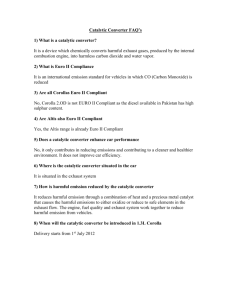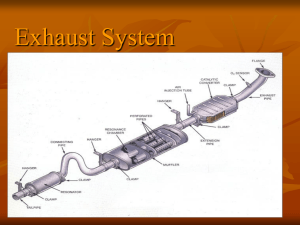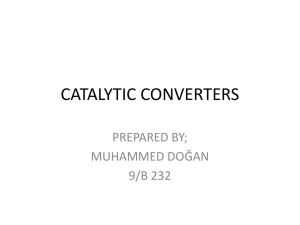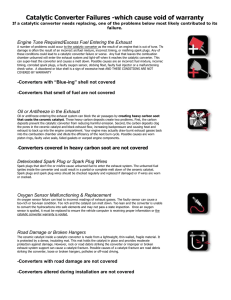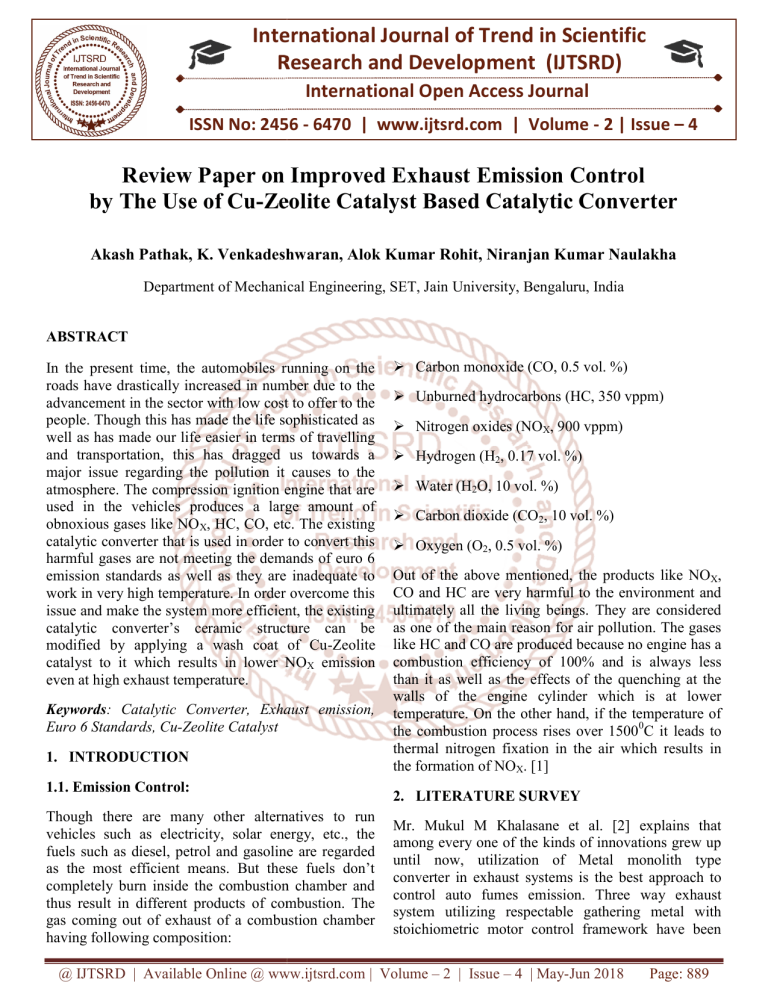
International Journal of Trend in Scientific
Research and Development (IJTSRD)
International Open Access Journal
ISSN No: 2456 - 6470 | www.ijtsrd.com | Volume - 2 | Issue – 4
Review Paper on Improved Exhaust Emission Control
by The Use of Cu-Zeolite
Zeolite Catalyst Based Catalytic Converter
Akash Pathak, K. Venkadeshwaran, Alok Kumar Rohit, Niranjan Kumar Naulakha
Department of Mechanical Engineering, SET, Jain University, Bengaluru, India
ABSTRACT
In the present time, the automobiles running on the
roads have drastically increased in number due to the
advancement in the sector with low cost to offer to the
people. Though this has made
ade the life sophisticated as
well as has made our life easier in terms of travelling
and transportation, this has dragged us towards a
major issue regarding the pollution it causes to the
atmosphere. The compression ignition engine that are
used in the vehicles
hicles produces a large amount of
obnoxious gases like NOX, HC, CO, etc. The existing
catalytic converter that is used in order to convert this
harmful gases are not meeting the demands of euro 6
emission standards as well as they are inadequate to
work in very high temperature. In order overcome this
issue and make the system more efficient, the existing
catalytic converter’s ceramic structure can be
modified by applying a wash coat of Cu
Cu-Zeolite
catalyst to it which results in lower NOX emission
even at high exhaust temperature.
Keywords:: Catalytic Converter, Exhaust emission,
Euro 6 Standards, Cu-Zeolite Catalyst
1. INTRODUCTION
1.1. Emission Control:
Though there are many other alternatives to run
vehicles such as electricity, solar energy, etc., the
fuels such as diesel, petrol and gasoline are regarded
as the most efficient means. But these fuels don’t
completely burn inside the combustion chamber and
thus result in different products of combustion. The
gas coming out of exhaust of a combustion chamber
having following composition:
Carbon monoxide (CO, 0.5 vol. %)
Unburned hydrocarbons (HC, 350 vppm)
Nitrogen oxides (NOX, 900 vppm)
Hydrogen (H2, 0.17 vol. %)
Water (H2O, 10 vol. %)
Carbon dioxide (CO2, 10 vol. %)
Oxygen (O2, 0.5 vol. %)
Out of the above mentioned,
tioned, the products like NOX,
CO and HC are very harmful to the environment and
ultimately all the living beings. They are considered
as one of the main reason for air pollution. The gases
like HC and CO are produced because no engine has a
combustion efficiency
iciency of 100% and is always less
than it as well as the effects of the quenching at the
walls of the engine cylinder which is at lower
temperature. On the other hand, if the temperature of
the combustion process rises over 15000C it leads to
thermal nitrogen fixation in the air which results in
the formation of NOX. [1]
2. LITERATURE SURVEY
Mr. Mukul M Khalasane et al. [2] explains that
among every one of the kinds of innovations grew up
until now, utilization of Metal monolith type
converter in exhaust systems is the best approach to
control auto fumes emission. Three way exhaust
system utilizing respectable gathering metal with
stoichiometric motor control framework have been
@ IJTSRD | Available Online @ www.ijtsrd.com | Volume – 2 | Issue – 4 | May-Jun
Jun 2018
Page: 889
International Journal of Trend in Scientific Research and Development (IJTSRD) ISSN: 2456-6470
produced for use on transports, trucks, and bikes and
also on rough terrain vehicles. Narendrasinh R.
Makwana et al. [3] summarise about selective
catalytic converter (SCR) innovation concerning
mileage , the prerequisite of a rich consume engine to
run at a the stoichiometric point at implies utilizes
more fuel than a "lean consume" engine running at a
blend of 20:1 or less. Be that as it may, NOx control
on lean consume engine is difficult. However, the
Specific Selective catalytic converter (SCR)
innovation with the capacity to convey close to zero
discharges of Nitrogen Oxides (NOx). Ankush
Ghodke et al. [4] this paper gives the information
about by consolidating the residue filter and selective
catalytic convertor, it will fulfill the objective i.e. low
weight-volume proportion and High NOx reduction in
high temperature. Changing the catalytic convertor
may solve the issues and the euro 6 emanation
standards will be fulfilled. Julie M Pardiwala et al. [5]
shows limited availability, cost and some working
conditions have propelled the research on alternate
catalyst material. Michael Rice et al. [6] shows the
rules and laws with regard to emission from the diesel
engine that have changed in the last two decades
along with the ways to reduce exhaust emission using
SCR combined with soot filter. Yisun cheng et al. [7]
illustrates concerns regarding sulphur poisoning in the
system incorporating Diesel Oxidation Catalyst for
applications of diesel engine ahead of Cu/Zeolite
Selective catalytic reduction (SCR) catalyst.
3. CATALYTIC CONVERTER
Catalytic converter is a setup installed in the exhaust
pipe of the engine which converts the toxic gases into
less harmful ones. The harmful gases emitting from
the combustion of gasoline and diesel have hazardous
effect on human life as well as on atmosphere. These
gases mainly include CO, HC and NOX. It was
invented by a French Mechanical engineer Eugene
Houdry in the year 1950, In order to control these
harmful emissions catalytic converters are used.
Different alternatives are examined to control the
harmful exhaust gases such as by blending additives
with fuel, modifying engine design, pretreatment of
fuel, treatment of exhaust gases. The catalytic
converter is the best suited option for reducing the
exhaust emissions level from vehicles among all the
available options till date. The catalysts in catalytic
converter turns poisonous gases like CO, HC and
NOX into CO2, H2O, N2, and O2.
Fig 1: Catalytic Converter
3.1. Major parts of Catalytic Converter
a) Stainless Steel Housing:
It gives adequate frame support and protection to the
substrate. Insulating materials with seals are provided
to protect the material from burn out. Insulating
materials are generally made up of metal wire mesh.
b) Substrate:
Substrate is a porous ceramic honeycomb structure
installed inside the converter made of metal wire
(stainless steel). It works as a support system and also
known as catalyst support developed by Rodney
Bagley, Irwin Lachman and Ronald Lewis for
providing maximum surface exposure to exhaust
gases.
c) Washcoat:
Composition of Alumina and silica is used as
washcoat for making the converter to work more
efficiently compared to flat core surfaces introducing
washcoat to substrate gives more surface exposure for
sits to active noble metals which is being added to
washcoat before its use on substrate.
d) Catalyst:
Catalyst is a noble group metal used in catalytic
converter and is very costly. Platinum, Palladium, and
Rhodium is the most widely used metals as active
catalyst worldwide. For secondary reaction to occur
another costlier metal called Rhodium is used. For
oxidation reaction to occur Platinum and Palladium
are used as well as for reduction reaction Platinum
and Rhodium are used. Based on the reaction
@ IJTSRD | Available Online @ www.ijtsrd.com | Volume – 2 | Issue – 4 | May-Jun 2018
Page: 890
International Journal of Trend in Scientific Research and Development (IJTSRD) ISSN: 2456-6470
occurring in the converter, they are of following main
types:
1) Oxidation reaction
converter:
/
Two
way
catalytic
As it deals only with unburnt and partially burnt fuel
i.e. hydrocarbons and carbon monoxide, it is known
as two way catalytic converter. Here carbon monoxide
gets oxidized to carbon dioxide and hydrocarbons gets
oxidized to carbon dioxide and water. Hence it is
known as oxidation reaction. In this method the
oxidation reaction takes place by using aluminum
oxide deposited with platinum on a support material
and the entire unit is placed in the exhaust stream of
combustion chamber. When carbon monoxide and
hydrocarbons passes through it following reaction
takes place:
3.2. Working of a Catalytic Converter:
Out of the above mentioned types of catalytic
converter, the most widely used type is three-way
catalytic converter. This is because here along with
oxidation reaction, reduction of NOX is also
accompanied with size of the catalytic converter
almost remaining the same.[8] As discussed above in
the three way catalytic converter, both reduction
catalyst and oxidation catalyst are employed. In this
type, platinum, rhodium and/or palladium (noble
metals) are coated on a ceramic structure because this
type of structure provides larger surface area to the
exhaust stream.
a) Carbon monoxide (partially burnt) oxidizes to
carbon dioxide
2CO + O2 → 2CO2
b) Hydrocarbon (unburnt) oxidizes to carbon dioxide
and water
CnH2n+2 + [(3n+1)/2] O2→ nCO2 + (n+1) H2O
2) Reduction reaction / Three way catalytic
converter:
In this type of catalytic converter, along with
hydrocarbons and carbon monoxides, the NOX
emission is also converted into less harmful gases.
NOX gas emission is produced at high temperature i.e.
more than 15000C. Here, both oxidation and reduction
reaction takes place and both oxidation and reduction
catalysts are present in the same housing except in
some cases where there are present separately. Here,
the following reactions takes place:
Fig 2: Working of Catalytic Converter
Here, platinum and rhodium catalysts are present in
the first stage of the converter where reduction
reaction takes place i.e. NOX emission is converted
into stable nitrogen and oxygen which are not
harmful. Similarly, oxidation reaction takes place in
the second stage where hydrocarbons and carbon
monoxide gets oxidized to water and carbon dioxide
by burning the hydrocarbons and carbon monoxide
passing it over a platinum and palladium catalyst. [9]
3.3. Problems in the existing catalytic converter:
1) High weight to volume ratio:
b) Oxidation of carbon monoxide to carbon dioxide:
It is desired to have a light weight catalytic converter
because increase in its weight results ultimately
increases the weight of the vehicles. But the
conventional catalytic converter has high weight to
volume ratio which increases the weight of the vehicle
and increases the consumption of fuel to drive the
vehicle.
2CO + O2 → 2CO2
2) Low working range of catalysts:
c) Oxidation of unburnt hydrocarbons (HC) to
carbon dioxide and water:
The catalysts i.e. platinum and palladium used for the
reduction of NOX have very low working range.
Hence, at very high temperature the NOX emission
produced is not completely reduced and is emitted to
a) Reduction of nitrogen oxides to nitrogen and
oxygen:
2NOn → nO2 + N2
CnH2n+2 + [(3n+1)/2] O2→ nCO2 + (n+1) H2O
@ IJTSRD | Available Online @ www.ijtsrd.com | Volume – 2 | Issue – 4 | May-Jun 2018
Page: 891
International Journal of Trend in Scientific Research and Development (IJTSRD) ISSN: 2456-6470
the atmosphere from the exhaust which make the
catalytic converter inefficient.
3) Inability of the converter to meet the Euro 6
norms:
The euro 6 norms that were used earlier have been
changed and the NOX emission standards have been
reduced. But the existing catalytic converter doesn’t
meet the euro 6 norms as the emission of the NOX is
comparatively higher which makes it necessary to
modify the converter to meet the norms.
4) High back pressure:
The conventional catalytic converter have a major
back pressure problem which leads to other different
problems resulting in decreased engine performance
and high fuel consumption. If the back pressure is
increased to much larger extent it may also cease the
engine completely.
3.4 Improvement
Converter
in
the
existing
Catalytic
All the above problems arise mainly due to the
catalyst that is used in order to trigger the reaction.
Therefore, introducing a new catalyst instead of the
existing ones which can work better in terms of
triggering the reaction as well as solve the above
mentioned problems would be the main objective
while modifying the catalytic converter. So, the idea
would be to merge the soot filter and monolith
structure’s SCR layers with a new catalyst i.e. CuZeolite. Cu-Zeolite comprises of two main chemicals
which are:
1. Zeolite powder (ZSM 5)
2. Cupric acetate hydrate
Introducing a new catalyst will not be enough to
tackle all the problems with the conventional catalytic
converter because of its complexity. So, it is also
important to a catalytic converter that would be
simple in design as well as smart in operation. In
order to achieve this, the most feasible way would be
to combine Catalyst Soot Filter (CSF) and Selective
Catalytic Reduction (SCR) as one component by
placing SCR’s active mass on the CSF’s filter
substrate. The integrated system as a whole is known
as SCR on filter or simple SCROF which abbreviates
to Selective Catalytic Reduction on Filter. This
combination when used for diesel engine would
reduce the NOX emission as per the Euro 6 norms. In
simple terms, SCROF is the integration of two types
of existing diesel exhaust system viz. SCR and CSF
which are solely inefficient to reduce the NOX
emission to desired level.
4. CONCLUSION
Among all the available catalyst used in the catalytic
converter, the Cu-Zeolite stands as the ideal catalyst
to overcome the problems seen in the conventional
catalytic converter as well as improving the
performance of the engine and CI engine’s emission
parameters. On the other hand, the combination of the
CSF and CSR would lead to solve the problem of high
weight to volume ratio and low NOX reduction of the
earlier available converters. It would also help to
achieve the main objective of meeting the Euro 6
norms.
5. ACKNOWLEDGEMENT
The authors wish to acknowledge the support
provided by the School of Engineering and
Technology, Jain University, Bangalore in preparation
of this manuscript.
REFERENCES
1. R. M. Kakwani, K.Voss, J. Patchett & K.Grimston
Engelhard, “Combined Catalyzed Soot Filter and
SCR Catalyst system for Diesel Engine Emission
Reduction”.6th diesel engine emission reduction
(DEER) workshop, August 20, 2000 San Diego,
California.
Fig 3: Schematic of Improved Catalytic Converter
2. Mukul M Khalasane, “A review paper on catalytic
converter for automatic exhaust emission.”
3. Narendrasinh R. Makwana, Prof. Shyam K.
Dabhi, “Automotive Exhaust Technology after
@ IJTSRD | Available Online @ www.ijtsrd.com | Volume – 2 | Issue – 4 | May-Jun 2018
Page: 892
International Journal of Trend in Scientific Research and Development (IJTSRD) ISSN: 2456-6470
Treatment for the Reduction of Emission-A
Review Study.”
4. Ankush Ghodke, Ganesh Gage, Amol Madane,
Avinash Shinare, Naik K.S., “Improved Catalytic
Convertor for CI Engine Emission Control
System.”
5. Julie M Pardiwala, Femina Patel, Sanjay Patel,
“Review paper on Catalytic Converter for
Automotive Exhaust Emission.”
6. Michael Rice, Jan Kramer, Klaus Mueller-Haas,
Raimund
Mueller.
“Innovative
Substrate
Technology for High Performance Heavy Duty
Truck SCR Catalyst Systems”. 2007 SAE
International.
7. Yisun Cheng, Christine Lambert, Do Heui Kim, Ja
Hun Kwak, Charles H.F. Peden, “Investigation of
Sulfur Deactivation on Cu/Zeolite SCR Catalysts
in Diesel Application”. August 4, 2009 2009
DEER Conference.
8. Hans-Dieter Harder, Marc Braggers, Rolf
Brück,“Future SCR NOX Aftertreatment Systems
for Euro 6.”
9. Dr. R. Samuel Boors’, Dr. Martin Diatreme, Dr.
Kenneth Voss, Dr. Susanne Stiebels, Dr. Claudia
Wendt, Dr. Torsten Neubauer, “Two in One: SCR
on Filter”. BASF Catalysts Germany GmbH;
Freundallee
23,
30173
Hannover.”
@ IJTSRD | Available Online @ www.ijtsrd.com | Volume – 2 | Issue – 4 | May-Jun 2018
Page: 893



